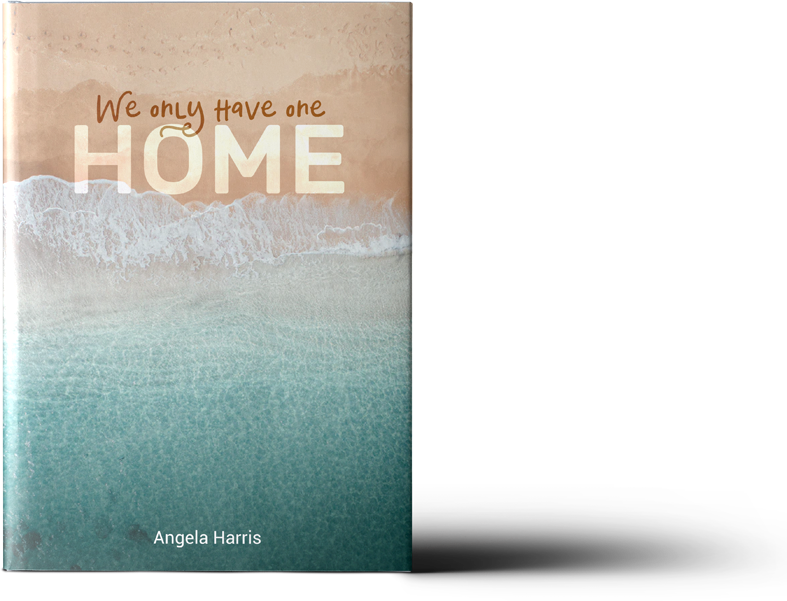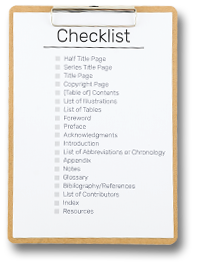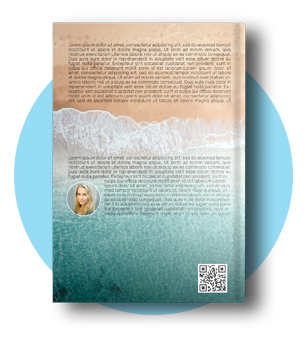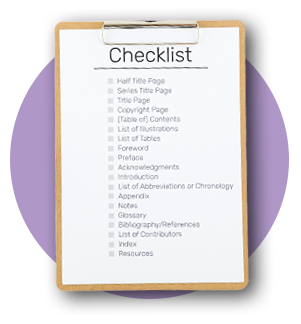Parts of Your Book
What is the beginning of a book called? What about the back of a book? Can you name at least six parts of a book?
As an author, you should have a firm grasp of what comprises a professionally made book. Including all the necessary parts of a book and putting them in the right order is the first step to making your book credible. The inside of your book, which we call the book block, is divided into three main sections: the front matter, book block text, and back matter.
You must make sure that the manuscript you submit to us includes all three sections combined into a single document and in the correct format. To give you some help, we’ve broken down all the parts of your book.

CONTENTS
Front matter
Front matter introduces your book to your readers. Appearing before the main text, it usually contains just a few pages that include the book's title, the author's name, the copyright information, and perhaps even a preface or a foreword. You don’t have to include all of them, though! It’s up to you to determine what’s suitable to your book.
Half Title Page
The half title page is the first page of your book and contains your title only. This page does not include a byline or subtitle. The designer will add this to your book layout.
Series Title Page
Use the second page of your book to list any of your previously published books by title. It is customary to list the books chronologically from first to most recently published. Listing the title only is standard, but in nonfiction works, you may also list the subtitle if you feel it is essential. A common way to begin this page is, "Also by [author's name] ..."
Title Page
The title page is the part of your book that shows your full book title and subtitle, your name, and any co-writer or translator. iUniverse will add its logo and locations at the bottom of the page. The designer will add this to your book layout, although if you have a specific idea of how you want this to look, you may include it.
Copyright Page
The copyright page contains the copyright notice, which consists of the year of publication and the name of the copyright owner. The copyright owner is usually the author but may be an organization or corporation. This page may also list the book's publishing history, permissions, acknowledgments, and disclaimers.
Copyright Page
The copyright page contains the copyright notice, which consists of the year of publication and the name of the copyright owner. The copyright owner is usually the author but may be an organization or corporation. This page may also list the book's publishing history, permissions, acknowledgments, and disclaimers.
Please note: iUniverse provides you with a standard copyright page that incorporates your individual information and the International Standard Book Number (ISBN).
(Table of) Contents
A table of contents, or simply “Contents,” is the part of a book that is usually used only in nonfiction works that have parts and chapters. A contents page is less common in fiction works but may be used if your work includes unique chapter titles. A table of contents is never used if your chapters are numbered only (e.g., Chapter One, Chapter Two). If your book requires a contents page, please make sure it lists all the chapters or other divisions (such as poems or short stories) in your manuscript. Chapter listings must be worded exactly as they are in the book itself.
Please do not include page numbers in your contents page—iUniverse will add page numbers during the formatting stage.
List of Illustrations
If your book includes several key illustrations that provide information or enhance the text in some way, consider creating a page that lists them. If this material is included simply for comic relief or as a visual aid, a page listing may not be necessary. Just as with the table of contents, you won't need to list the page numbers.
List of Tables
If your book includes several key tables that provide information or enhance the text in some way, consider creating a page that lists them. If this material is included simply as a visual aid, a page listing may not be necessary. Just as with the table of contents, you won't need to list the page numbers.
Foreword
The foreword contains a statement about the book and is usually written by someone other than the author who is an expert or is widely known in the field of the book's topic. A foreword lends authority to your book and may increase its potential for sales. If you plan to include a foreword, please arrange to have it written and included in your submitted manuscript. A foreword is most commonly found in nonfiction works.
Preface
The preface usually describes why you wrote the book, what your research methods are, and perhaps some acknowledgments if they have not been included in a separate section. It may also establish your qualifications and expertise as an authority in the field in which you're writing. Again, a preface is far more common in nonfiction titles and should be used only if necessary in fiction works.
Acknowledgments
An acknowledgments page includes your notes of appreciation to people who provided support or help during the writing process or in your writing career in general. This section may also include any credits for illustrations or excerpts if not included on the copyright page. If the information is lengthy, you may choose to put the section in the back matter, before or after the bibliography.
Introduction
The introduction describes something about the main text that your reader should know before proceeding to read the book. Unlike a preface, which usually addresses the qualifications of the author, an introduction refers to the main body of the work itself. For example, if there are questions at the conclusion of each chapter, here is where you might prepare the reader and give tips on how best to use them. The introduction may also describe, in more detail than a preface, the research, methods, and overall concept of the book.
List of Abbreviations or Chronology
If many abbreviations are used or if a few are used frequently, a list is useful. Its location should always be given in the table of contents. Alphabetize terms by the abbreviation, not by the spelled-out form.
Back matter
Your book submission is not complete unless it includes the information that goes into the back of your book, or back matter. Does your book require notes? An index? A resource list? To help you decide, we've provided the following descriptions for each of the common back matter sections.
Appendix
An appendix includes any data that might help clarify the text for the reader but would have disrupted the flow of the main text had it been included in an earlier part of the book. Some items included here might be a list of references, tables, reports, background research, and sources, if not extensive enough to be included in a separate section.
Notes
If your main text requires notes to amplify or document certain passages throughout the text, please arrange the notes by chapter in a notes section. Footnotes would more likely be included in the references section.
Glossary
A glossary comprises alphabetically arranged words and their definitions. Be sure to include one if you use terminology that is not generally known to the average reader or if you coin new words or phrases to explain your ideas.
Bibliography or References
Both the bibliography and reference sections list the sources for works used in your book. Be sure to arrange the sources alphabetically by the author's last name. For samples and guidelines on proper layout, refer to the Chicago Manual of Style, 16th edition, or consult the notes provided by the University of Wisconsin–Madison.
List of Contributors
A list of contributors is useful for a multi-author work where only the volume editor’s name appears on the title page. You should arrange entries alphabetically by last name, but do not invert them (“John H. Doe,” not “Doe, John H.”). If it’s necessary, you may also add brief biographical notes and academic affiliations for each entry.
Index
The index is an alphabetically ordered list of words and terms used for referencing your text. Please keep in mind that the computer-generated keyword index that lists a page number for a key term every time it occurs in your book tends to be overly long and has no logical organization other than alphabetization.
On the other hand, a professional indexer analyzes your entire book, anticipates subject items your reader will most likely want to find, and lists them in an intuitively accessible manner. For applicable titles, iUniverse offers for purchase the optional editorial service of a professional indexer who considers the focus, purpose, audience, and organization of your book to create an industry-standard, two-level index that is fully copy edited and proofread.
Resources
Often, readers want to buy products or join organizations in the field in which you've written. A list of organizations and associations, manufacturers and distributors, websites, and other sources are invaluable to your readers.
Checklist
Use this checklist to keep track of the sections that you think are necessary for your book. You can refer to it while you arrange the parts of your book and during your publishing consultation.
Half Title Page
Series Title Page
Title Page
Copyright Page
(Table of) Contents
List of Illustrations
List of Tables
Foreword
Preface
Acknowledgments
Introduction
List of Abbreviations or Chronology
Appendix
Notes
Glossary
Bibliography/References
List of Contributors
Index
Resources
By clicking “Request My Free Consultation”, you are providing your electronic signature, voluntarily authorizing iUniverse and its affiliates to contact you using a manual or automated telephone dialing system and send you advertisement or telemarketing messages by email or text/SMS/MMS message to the address and phone number you have provided above. You are not required to agree to this in order to buy products or services from iUniverse. You certify that you are over the age of eighteen (18). You’ll get up to ten (10) messages per month. Standard message and data rates may apply. Click here to view our privacy policy.






